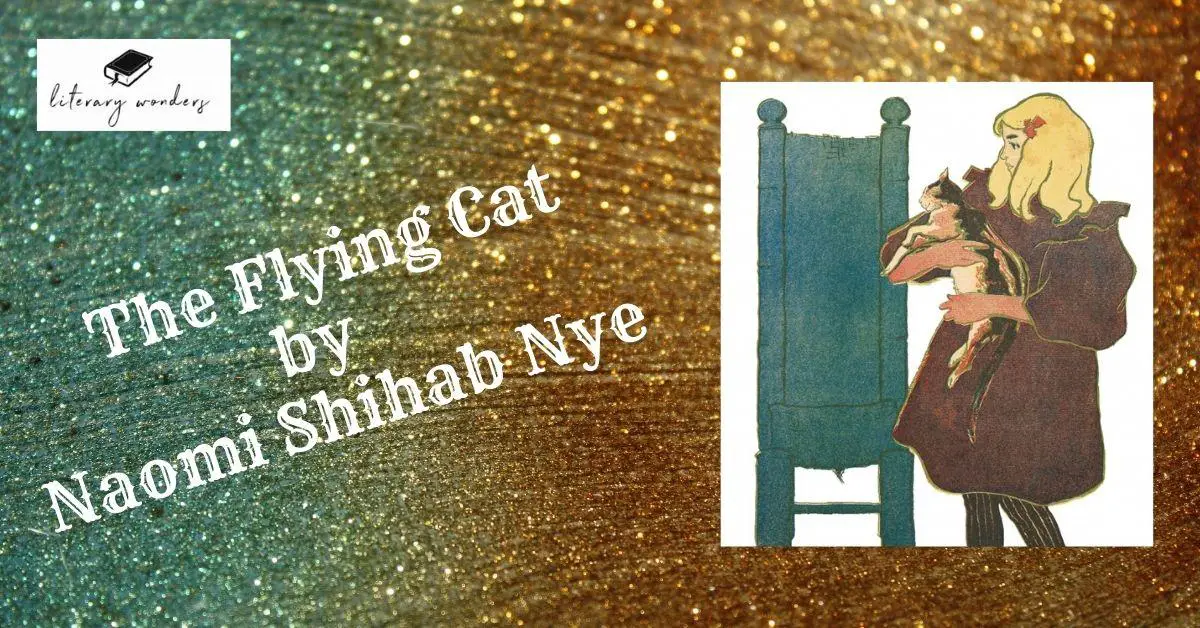Introduction of “The Flying Cat” by Naomi Shihab Nye
“The Flying Cat” by Naomi Shihab Nyefeatures the kind and solicitous nature of humanity. However, it also explores the ideas of pain, silent fear, and dutifulness. It begins when the speaker expresses her greatest fear. She seems worried because she is going to take her cat on board a flight. To ensure the cat’s safety, she comes up with various questions such as air pressures, air holes, luggage, etc. From these concerns, she highlights how sometimes life puts us in tricky and unexpected situations.
She believes that her pet trusts her and, she is solely responsible for his safety. Therefore, she places herself in the animal’s place and wonders how this tiny innocent creature will survive inside a confined space for a long time. While expressing the innocence of the cat, she states that the poor creature knows nothing about the world. He is also unaware of the expedition he is going to undertake. Therefore, she simply sympathizes with the cat whose fate is in his master’s hand.
Major Themes in “The Flying Cat”
“The Flying Cat” by Naomi Shihab Nye exhibits various universal themes such as; Animal love, unexpected challenges of life, and travel issues. The speaker of the poem possesses a special place for her pet in her heart. She feels responsible for his comfort and safety. She might have kept her animal with great care; that is why she is trying to sort out everything before boarding a flight with the cat. Since it’s the first time the cat is flying with her, she asks all the necessary questions to ensure his safety.
Besides discussing her concerns in the poem, the writer tries to drag the readers toward the uncertainties that life throws in our ways. Sometimes we seem immovable when one single thought starts haunting our life day and night. She argues that sometimes we get stuck in a do-or-die situation that demands a quick and sudden reaction from our side. Thankfully, humans are flexible creatures; they quickly adapt to all conditions and act accordingly.
Analysis of Poetic Elements Used in “The Flying Cat”
“The Flying Cat” by Naomi Shihab Nye shows various poetic elements such as imagery, symbolism, metaphor, and other rhetoric devices. The start of the poem displays the poem’s anxious, depressing tone, which makes it easy for the readers to grasp the writer’s idea from the very first line. Moreover, addressing the audience from the start connects the audience to the subject matter effectively. The way she informs the readers about the haphazard situation she is confronting shows that she wants them to feel her anxiety.
Another evident literary element used in the poem is imagery. Naomi Shihab Nye has sensibly used powerful words to portray the situation in the reader’s imagination, such as; “Hugging the cat before departure, you realize again” and “Ma’am, if the cabin weren’t pressurized, your cat would explode.” These images help the readers visualize the situation, like how difficult it would have been for the speaker to manage this challenging situation. Furthermore, she has used various symbols to connect the readers with her intended emotions and ideas, such as; “luggage of pain,” which symbolizes her extreme fears.
Besides using these elements, she has also used anxiety as an extended metaphor to show how it makes our senses go numb for some time. It bluntly makes people blind. No matter how clever, witty and sharp-minded a person is, once he gets anxious about something, he loses the power to differentiate between right and wrong.
In- Depth Analysis of “The Flying Cat” by Naomi Shihab Nye
“The Flying Cat” by Naomi Shihab Nye is divided into five stanzas of varied length. However, each stanza makes the intended meanings of the poem clear to the readers. The analysis of the stanzas is as follows.
Stanza#1
The first stanza introduces us to the speaker’s tension. She is traveling to a distant city and has to bring her cat along. Now, the cat is supposed to be placed in a small box with holes. She seems extremely worried about the travel as she has never experienced such air travel before.
Stanza#2
The second stanza further extends her anxiety as she thinks about her pet’s situation. Since she is a regular traveler, she is aware of the challenges her cat might face during the flight. First, she thinks about the small baggage compartment that is unfit for any living creature. Then, she thinks about how this poor creature will survive during take-off when the situation gets more challenging.
Stanza#3
She approaches Air Help to help and ask the triggering questions one by one to clarify her fears. Sometimes she gets the appropriate answers, but sometimes she is directed to online assistance. She expresses how sometimes worries and tensions affect everything you do. From eating to sleeping and working, the whole cycle gets disturbed by one single thought that how her cat is going to survive in the plane.
Stanza#4
In this stanza, she further asks some questions from the cabin crew. To ensure her cat’s safety, she again asks technical and logical questions from one of the members. Instead of easing her grief, the lady’s impersonal tone and cold reply to her dismay.
Stanza#5
The final stanza sheds light on her caring and loving nature. Since all her woes revolve around her pet, therefore, she hugs her cat before boarding a flight. She makes herself responsible for her safe travels. She believes that the cat trusts her; his owner will never put him in a challenging and troubling situation. The cat’s innocence is also highlighted in this specific stanza; the speaker says that he knows nothing about planets, satellites, space, and black holes. It shows sympathy to the cat who has not a right and whose fate is held in the owner’s hands.
See Also:
Kindness by Naomi Shihab Nye Analysis

